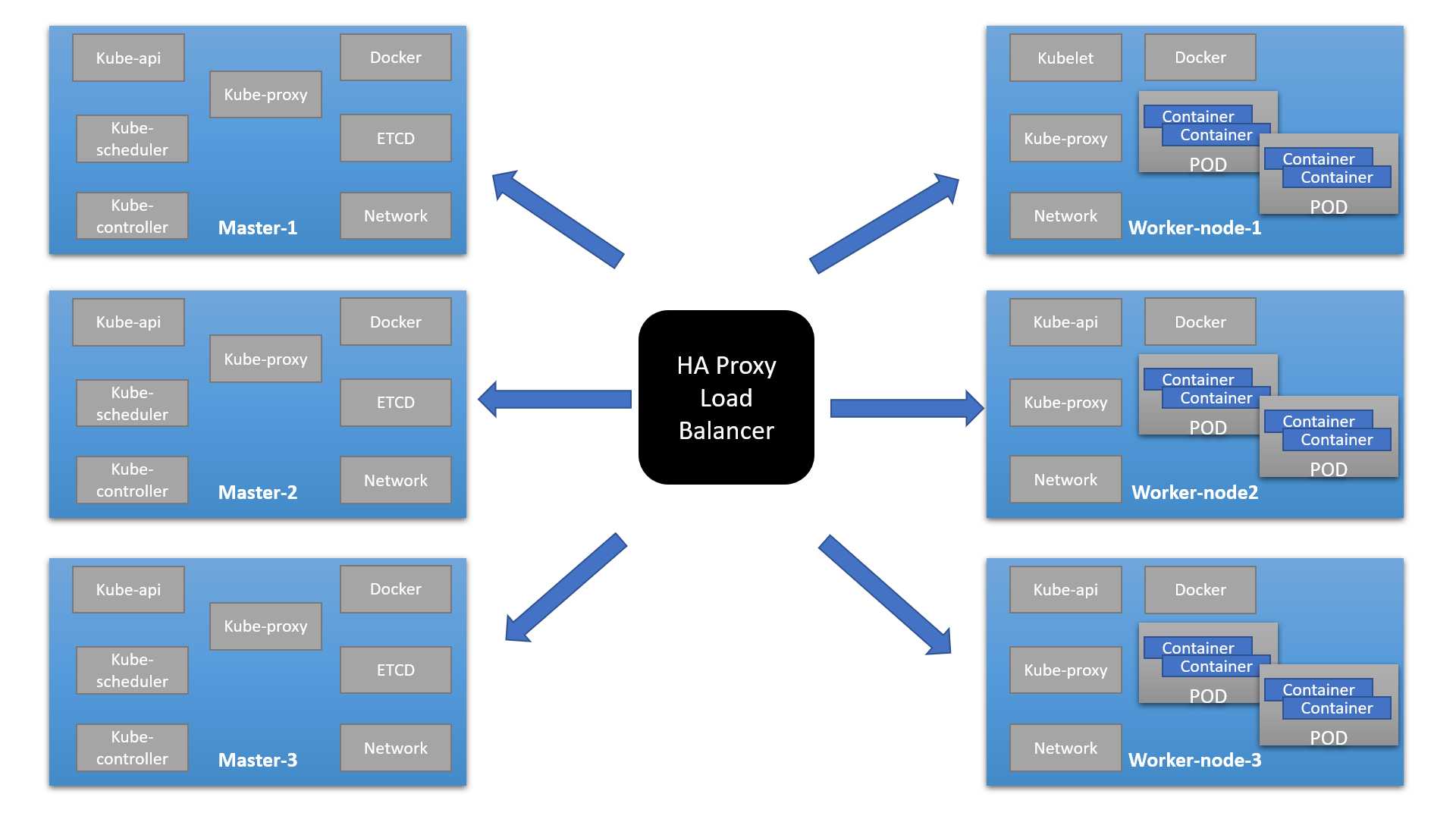准备机器列表如下
机器列表如下:
| IP地址 | hostname |
|---|---|
| 10.158.1.9 | k8s-master-03 |
| 10.158.1.8 | k8s-master-02 |
| 10.158.1.7 | k8s-master-01 |
| 10.158.1.5 | k8s-worker-05 |
| 10.158.1.4 | k8s-worker-04 |
| 10.158.1.3 | k8s-worker-03 |
| 10.158.1.2 | k8s-worker-02 |
| 10.158.1.1 | k8s-worker-01 |
准备Etcd环境
节点准备kubeadm基本环境
每个节点需要安装的软件
| 软件包 | 版本 |
|---|---|
| kubeadm | 1.16.1 |
| docker | 19.03.5 |
| kubelet | 1.16.1 |
| kubectl | 1.16.1 |
kubeadm: 部署集群用的命令kubelet: 在集群中每台机器上都要运行的组件,负责管理pod、容器的生命周期kubectl: 集群管理工具(可选,只要在控制集群的节点上安装即可)
添加yum源
cat <<EOF | sudo tee /etc/yum.repos.d/kubernetes.repo[kubernetes]name=Kubernetesbaseurl=http://mirrors.aliyun.com/kubernetes/yum/repos/kubernetes-el7-x86_64enabled=1gpgcheck=0repo_gpgcheck=0gpgkey=http://mirrors.aliyun.com/kubernetes/yum/doc/yum-key.gpghttp://mirrors.aliyun.com/kubernetes/yum/doc/rpm-package-key.gpgEOF# 找到要安装的版本号,目前最新为1.16.1yum list kubeadm --showduplicates | sort -r# 安装指定版本1.16.1yum install -y kubeadm-1.16.1-0 kubelet-1.16.1-0 kubectl-1.16.1-0 --disableexcludes=kubernetes# 设置kubelet的cgroupdriver(kubelet的cgroupdriver默认为systemd,如果上面没有设置docker的exec-opts为systemd,这里就需要将kubelet的设置为cgroupfs)# 这里我上面设置了docker的exec-opts为systemd,所以跳过这一步sed -i "s/cgroup-driver=systemd/cgroup-driver=cgroupfs/g" /etc/systemd/system/kubelet.service.d/10-kubeadm.conf# 启动kubeletsystemctl enable kubelet && systemctl start kubelet
安装HAProxy
haproxy为kube-apiserver提供反向代理,haproxy将所有请求轮询转发到每个master节点上。相对于仅仅使用keepalived主备模式仅单个master节点承载流量,这种方式更加合理、健壮。
yum方式安装haproxy
yum install -y haproxy
编辑haproxy配置
cat <<EOF | sudo tee /etc/haproxy/haproxy.cfg
#---------------------------------------------------------------------
# Global settings
#---------------------------------------------------------------------
global
# to have these messages end up in /var/log/haproxy.log you will
# need to:
#
# 1) configure syslog to accept network log events. This is done
# by adding the '-r' option to the SYSLOGD_OPTIONS in
# /etc/sysconfig/syslog
#
# 2) configure local2 events to go to the /var/log/haproxy.log
# file. A line like the following can be added to
# /etc/sysconfig/syslog
#
# local2.* /var/log/haproxy.log
#
log 127.0.0.1 local2
chroot /var/lib/haproxy
pidfile /var/run/haproxy.pid
maxconn 4000
user haproxy
group haproxy
daemon
# turn on stats unix socket
stats socket /var/lib/haproxy/stats
#---------------------------------------------------------------------
# common defaults that all the 'listen' and 'backend' sections will
# use if not designated in their block
#---------------------------------------------------------------------
defaults
mode http
log global
option httplog
option dontlognull
option http-server-close
option forwardfor except 127.0.0.0/8
option redispatch
retries 3
timeout http-request 10s
timeout queue 1m
timeout connect 10s
timeout client 5m
timeout server 1m
timeout http-keep-alive 10s
timeout check 10s
maxconn 3000
#---------------------------------------------------------------------
# kubernetes apiserver frontend which proxys to the backends
#---------------------------------------------------------------------
frontend kubernetes-apiserver
mode tcp
bind *:16443
option tcplog
default_backend kubernetes-apiserver
#---------------------------------------------------------------------
# round robin balancing between the various backends
#---------------------------------------------------------------------
backend kubernetes-apiserver
mode tcp
balance roundrobin
server k8s-master-01 10.158.1.7:6443 check
server k8s-master-02 10.158.1.8:6443 check
server k8s-master-03 10.158.1.9:6443 check
#---------------------------------------------------------------------
# collection haproxy statistics message
#---------------------------------------------------------------------
listen stats
bind *:1080
stats auth admin:awesomePassword
stats refresh 5s
stats realm HAProxy\ Statistics
stats uri /admin?stats
EOF
启动并检测
systemctl enable haproxy.service
systemctl start haproxy.service
systemctl status haproxy.service
ss -lnt | grep -E "16443|1080"
LISTEN 0 128 *:1080 *:*
LISTEN 0 128 *:16443 *:*
kubeadm init指令初始化
config.yaml文件如下:
apiVersion: kubeadm.k8s.io/v1beta2
kind: ClusterConfiguration
kubernetesVersion: v1.16.1
apiServer:
certSANs:
- 10.158.1.9
- 127.0.0.1
controlPlaneEndpoint: "10.158.1.9:16443"
etcd:
external:
endpoints:
- https://10.158.1.9:2379
- https://10.158.1.8:2379
- https://10.158.1.7:2379
caFile: /etc/etcd/ca.pem
certFile: /etc/etcd/kubernetes.pem
keyFile: /etc/etcd/kubernetes-key.pem
networking:
podSubnet: 10.244.0.0/16
imageRepository: registry.aliyuncs.com/google_containers
apiServerExtraArgs:
apiserver-count: "3"
初始化第一个master节点
sudo kubeadm init --config config.yaml --v=5 --ignore-preflight-errors=all
安装成功输出大概如下所示:
Your Kubernetes control-plane has initialized successfully!
To start using your cluster, you need to run the following as a regular user:
mkdir -p $HOME/.kube
sudo cp -i /etc/kubernetes/admin.conf $HOME/.kube/config
sudo chown $(id -u):$(id -g) $HOME/.kube/config
You should now deploy a pod network to the cluster.
Run "kubectl apply -f [podnetwork].yaml" with one of the options listed at:
https://kubernetes.io/docs/concepts/cluster-administration/addons/
You can now join any number of control-plane nodes by copying certificate authorities
and service account keys on each node and then running the following as root:
kubeadm join 10.158.1.9:16443 --token xxxx \
--discovery-token-ca-cert-hash xxx \
--control-plane
Then you can join any number of worker nodes by running the following on each as root:
kubeadm join 10.158.1.9:16443 --token xxx \
--discovery-token-ca-cert-hash xxxx
安装网络插件flannel
配置文件如下所示:
cat <<EOF | sudo tee kube-flannel.yaml
---
kind: ClusterRole
apiVersion: rbac.authorization.k8s.io/v1beta1
metadata:
name: flannel
rules:
- apiGroups:
- ""
resources:
- pods
verbs:
- get
- apiGroups:
- ""
resources:
- nodes
verbs:
- list
- watch
- apiGroups:
- ""
resources:
- nodes/status
verbs:
- patch
---
kind: ClusterRoleBinding
apiVersion: rbac.authorization.k8s.io/v1beta1
metadata:
name: flannel
roleRef:
apiGroup: rbac.authorization.k8s.io
kind: ClusterRole
name: flannel
subjects:
- kind: ServiceAccount
name: flannel
namespace: kube-system
---
apiVersion: v1
kind: ServiceAccount
metadata:
name: flannel
namespace: kube-system
---
kind: ConfigMap
apiVersion: v1
metadata:
name: kube-flannel-cfg
namespace: kube-system
labels:
tier: node
app: flannel
data:
cni-conf.json: |
{
"name": "cbr0",
"plugins": [
{
"type": "flannel",
"delegate": {
"hairpinMode": true,
"isDefaultGateway": true
}
},
{
"type": "portmap",
"capabilities": {
"portMappings": true
}
}
]
}
net-conf.json: |
{
"Network": "10.244.0.0/16",
"Backend": {
"Type": "vxlan"
}
}
---
apiVersion: extensions/v1beta1
kind: DaemonSet
metadata:
name: kube-flannel-ds-amd64
namespace: kube-system
labels:
tier: node
app: flannel
spec:
template:
metadata:
labels:
tier: node
app: flannel
spec:
hostNetwork: true
nodeSelector:
beta.kubernetes.io/arch: amd64
tolerations:
- operator: Exists
effect: NoSchedule
serviceAccountName: flannel
initContainers:
- name: install-cni
image: registry.cn-shenzhen.aliyuncs.com/cp_m/flannel:v0.10.0-amd64
command:
- cp
args:
- -f
- /etc/kube-flannel/cni-conf.json
- /etc/cni/net.d/10-flannel.conflist
volumeMounts:
- name: cni
mountPath: /etc/cni/net.d
- name: flannel-cfg
mountPath: /etc/kube-flannel/
containers:
- name: kube-flannel
image: registry.cn-shenzhen.aliyuncs.com/cp_m/flannel:v0.10.0-amd64
command:
- /opt/bin/flanneld
args:
- --ip-masq
- --kube-subnet-mgr
resources:
requests:
cpu: "100m"
memory: "50Mi"
limits:
cpu: "100m"
memory: "50Mi"
securityContext:
privileged: true
env:
- name: POD_NAME
valueFrom:
fieldRef:
fieldPath: metadata.name
- name: POD_NAMESPACE
valueFrom:
fieldRef:
fieldPath: metadata.namespace
volumeMounts:
- name: run
mountPath: /run
- name: flannel-cfg
mountPath: /etc/kube-flannel/
volumes:
- name: run
hostPath:
path: /run
- name: cni
hostPath:
path: /etc/cni/net.d
- name: flannel-cfg
configMap:
name: kube-flannel-cfg
EOF
安装指令如下:
kubectl apply -f kube-flannel.yaml
“Network”: “10.244.0.0/16”要和kubeadm-config.yaml配置文件中podSubnet: 10.244.0.0/16相同
k8s-master-01和k8s-master-02节点准备证书
在两个节点分别创建/etc/kubernetes/pki/etcd目录
mkdir -p /etc/kubernetes/pki/etcd
scp /etc/kubernetes/admin.conf it@k8s-master-02:/etc/kubernetes
scp /etc/kubernetes/pki/{ca.*,sa.*,front-proxy-ca.*} it@k8s-master-02:/etc/kubernetes/pki
scp /etc/kubernetes/pki/etcd/ca.* it@k8s-master-02:/etc/kubernetes/pki/etcd
启动k8s-master-01和k8s-master-02
sudo kubeadm join 10.158.1.9:16443 --token xxxx \
--discovery-token-ca-cert-hash xxxx \
--control-plane --v=5 --ignore-preflight-errors=all
启动k8s-worker节点
在五个Worker节点分别运行
sudo kubeadm join 10.158.1.9:16443 --token xxx \
--discovery-token-ca-cert-hash xxxxx --v=5 --ignore-preflight-errors=all


